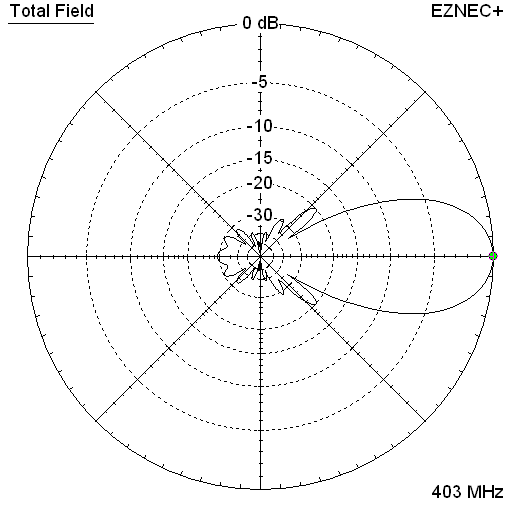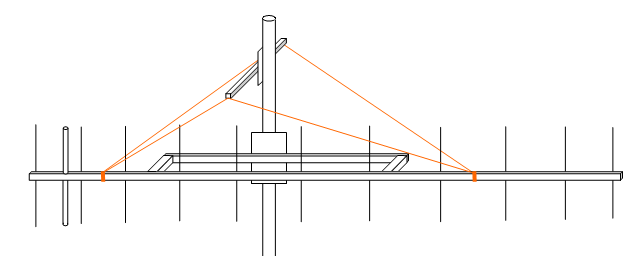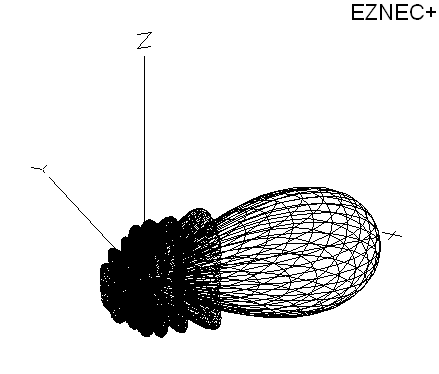
YBN RS-14w wideband Yagi for reception of Radio Sondes
Wideband version with SWR < 1:1.5 from 400 to 406 MHz
This Yagi is designed to meet expectations for easy building but clean pattern for the necessary bandwidth for monitoring
the complete 400 - 406 MHz Radio Sonde band. It is 50 ohms direct feed, the coax cable can be connected as is.
A ferrite core added on the fed line is welcome but not essential.
This design is developed using the GTV 70-14m 432 MHz Low Noise Yagi as baseline.
Current distribution

This far the YBN RS-14w has been built by Daniel, OM1ATS and Yves, F5RBP.
Daniel states "In first test antenna has very good SWR near 403 MHz".
Yves closely followed the given geometry of the wave guiding structure and
yields SWR in place too. He even modified the designs driver cell to fit a bent
Dipole on his own.
• see here for Plot and Photos of F5RBP's Yagi
Performance Data
402 MHz 403 MHz 404 MHZ
Gain vs. isotr. Rad. 16.1 dBi 16.1 dBi 16.2 dBi
Gain vs. Dipole 14.0 dBD 14.0 dBD 14.1 dBD
-3 dB E-plane 31.2 deg.
-3 dB H-plane 33.0 deg.
F/B -31.2 dB -28.9 dB -26.9 dB
F/R -25.8 dB -25.3 dB -24.3 dB
Impedance 50 ohms
Mechan. Length 3031 mm
Electr. Length 4.07 λ
Stacking Dist. h-pol.
top-to-bottom 1.31 m
side-by-side 1.38 m
Geometry

Applying the SBC factor of 1.02 mm/MHz tells us that the SBC to be added to the BC must be
(405.5 - 403.6) MHz x 1.02 mm/MHz = 1.94 mm
(corrected using right SBC factor for 403 MHz instead the 432 MHz number / 2014-07-10)
Boom Correction for mounting elements on boom with standard plastic insulators
The 8 mm element geometry data are to fit On-Boom-with-Standard-Insulators style (WiMo, Nuxcom, ...) of building.
Segmentation BC and Base BC (see below) must be added.


for final length, saw about 0,5 mm in front of the mark and grind down to final measure. Below you find BC numbers for
other boom dimension
Tube dim. BC SBC BC+SBC
Boom 20 x 20 mm 7.1 mm + 1.94 mm = 9.04 mm
Boom 25 x 25 mm 10.4 mm + 1.94 mm = 12.34 mm
Boom 1 x 1 in 10.7 mm + 1.94 mm = 12.64 mm
Elements through boom
For building with elements through boom see DL6WU/G3SEK Boom Correction Online Calculator
Do not miss out on adding the 1.94 mm of SBC.
Advanced feeding & symmetrising
Placing a ferrite an the feeding coax as close a possible to the dipole connection will do for any reception purpose
However - here is an advanced methode:
A simple symmetrising member may be made from a 3 x 1/4 Lambda line grounded at the far side with
N-flange-bushing and an aluminium plate and ferrite added as close as possible to the DE, see below.
Pattern and VSWR Plots
Elevation and Azimuth plot at 432.1 MHz (horizontally polarised - for vertical polarisation swap views)


SWR plots - inner band and full band


How came to visit this website?
Downloads
EZNEC file of this Yagi with 8 mm elements
Mounting a long vertically polarised Yagi

one. With help of a traverse and V-shaped kevlar, aramid or polyester guy ropes one can avoid boom sag
and add additional stability as now the supporting structure becomes 3 dimensional.
Place strut ends and guy rope fastenings as far away from elements as possible.
Stacking
Stacking Dist. DL6WU Formula v-pol 1.31 m
Data of 2 Yagi stack using DL6WU stacking distances

Gain vs. isotr. Rad. 19.0 dBi Gain vs. Dipole 16.8 dBD F/B -28.5 dB F/R -26.4 dB Theoretical numbers, no phasing line losses nor imperfections caused by H-frame included *) T_sky = 200 K, T_earth = 1000 K as in VE7BQH G/T table
Azimuth Plot of 2 x vertical polarised YBN RS-14w
(Elevation Plot is same as Az. Plot given for single Yagi in h-pol above)

Symmetrising 50 to 50 ohms Feedline
The principle is similar to the 1/4 Lambda coax. Adding 2 x 1/4 Lambda or a half wave line does not change anything but allows
to form a gentle bow below the boom or until behind the Reflector. Follow practical construction hints on "Building a Yagi" page.


|
Attenzione!
Take care when lengthening the coax, measure the right length instead of refering to given v-factors only. A good choice may be the diam. 5 mm PTFE coax RG-142 B/U: real resonate length (403 Mhz as 3/4 Lambda) shield-shield is around 373 mm |

|
Find more information
about getting the coax stub right on my Phasing & Matching Lines page |
73, Hartmut, DG7YBN


